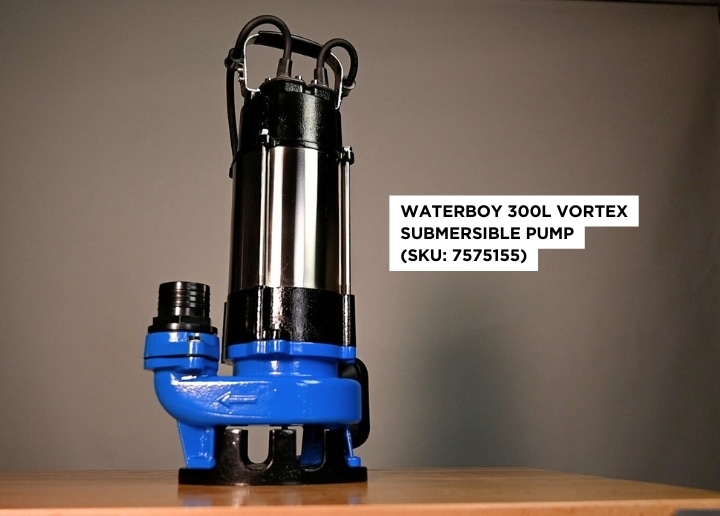Articles
April 4, 2024
Sewage pumps play a crucial role in maintaining proper sanitation by efficiently transporting wastewater and sewage from one location to another. As a plumber, understanding the different types of sewage pumps and their applications is essential. Let’s dive into the world of sewage pumps and explore the answers to common questions.
A sewage pump (also known as a wastewater pump) is a water pump that is used to handle wastewater and sewage in residential, commercial, and industrial settings. Its primary function is to move wastewater, including soft solids and other debris, from lower to higher elevations. These pumps come into play when gravity alone cannot effectively transport sewage—such as when the plumbing system is located below the sewer line or septic tank.
In domestic applications, sewage pumps are commonly centrifugal submersible pumps that are electrically driven. Centrifugal pumps are commonly used as they are simple to install, require minimal space and can be easier to maintain. The moving parts of centrifugal pumps are also quite durable, so they can last a long time. underground septic tanks and in pump stations (or lifting stations) to pump wastewater from various sources to the treatment plants.
There are many terms used to refer to wastewater pumps used in domestic homes and commercial buildings. Let’s break down common terms below.
Sewage Ejector Pumps refer to sewage pumps that specifically pump out wastewater where a plumbing fixture is located below the level of the main sewer or septic line flowing from the house and cannot rely on gravity alone to feed water into the septic tank. A basement ejector pump typically sits in a pump station, basin or tank. After water reaches a certain level, the wastewater is pumped out of the home and into sewer or septic pipes. Ejector pumps can handle high volumes of wastewater under low pressure.
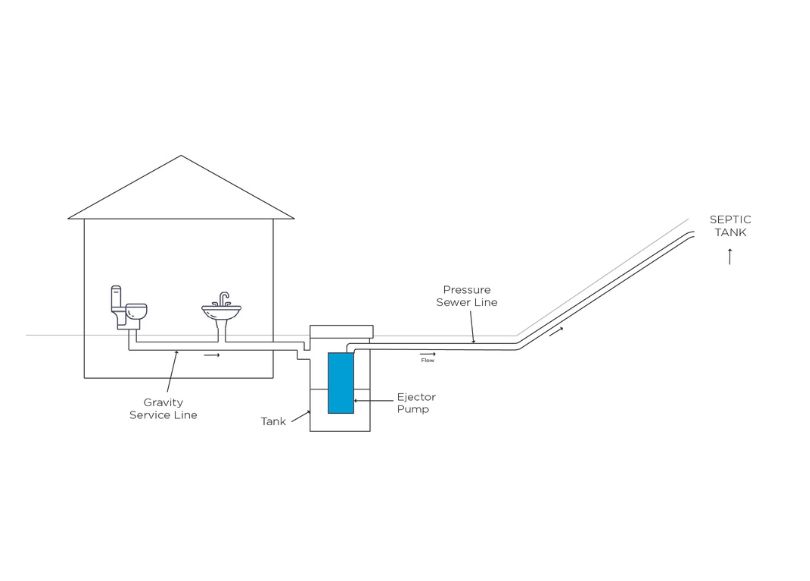
Grinder and cutter pumps are specifically used to pump raw sewage that may contain oversized materials. These pumps feature a special cutting mechanism that can process oversized materials and larger soft solids present in water. When the wastewater inside the tank reaches a certain level, the pump turns on and grinds the wastewater containing soft solids and pumps it into a pressurised sewer system. Sewage pumps such as the Waterboy 250L Grinder and Waterboy 270L Cutter can be used in this application. Grinding pumps may also been known as “submersible grinding pumps”.
Effluent Pumps are lighter duty wastewater pumps that are typically used to pump wastewater from a septic tank to a leach field. An effluent pump can handle smaller suspended soft solids. A vortex submersible pump such as the Waterboy 300L Vortex can be used in this application.
If you need to pump sewage it’s recommended to get a grinder or cutter pump. If you’re looking to pump to a septic tank or a gravity flow sewer main that doesn’t require pumping large solids then look for a sewage ejector pump. For pumping wastewater from a septic tank, look for an effluent pump or a pump that can handle smaller suspended solids.
Sump Pumps are submersible pumps that are used to drain unwanted water out of a “sump” pit or water-collecting basin found at the lowest point of a home, commonly in basements. Whilst sewage ejector pumps refer to submersible pumps that specifically pump out wastewater, a sump pump can refer to a pump that pumps out stormwater, ground water or any undesirable liquid that may build up and cause flooding.
Drainage Pumps typically refer to submersible pumps that drain clean or graywater containing none or minimal and fine soft solids in suspension.
Whilst sewage ejector pumps and sump pumps refer to pumps with different applications, in many cases a sewage ejector pump can be used as a sump pump and vice versa. A sump pump can also be a drainage pump for draining ponds and pools. Sewage pumps for example, can be used for applications especially where pumping wastewater or water containing soft solids is required. This can include:
When purchasing a pump, it’s important to consider your main application and what specifications are required. For example, if you’re installing a pump that processes toilet wastewater with sanitary products and faeces (blackwater) – you’ll need to look for a pump that can break down large materials, such as a grinder or cutter sewage pump.
For pumping raw sewage where materials such as cleaning wipes and sanitary products may be present, a grinder or cutter sewage pump is recommended. Grinder and cutter pumps can chop up debris into fine pieces and reduce potential blockage in sewer pipes and systems.
Cutter pumps are designed to handle raw sewage and heavy-industrial wastewater where oversized materials such as cleaning wipes, plastics, sanitary napkins and other materials may be present. With a powerful blade mechanism, they can cut materials into small pieces – making it easier for the pump to move the wastewater to the discharge.
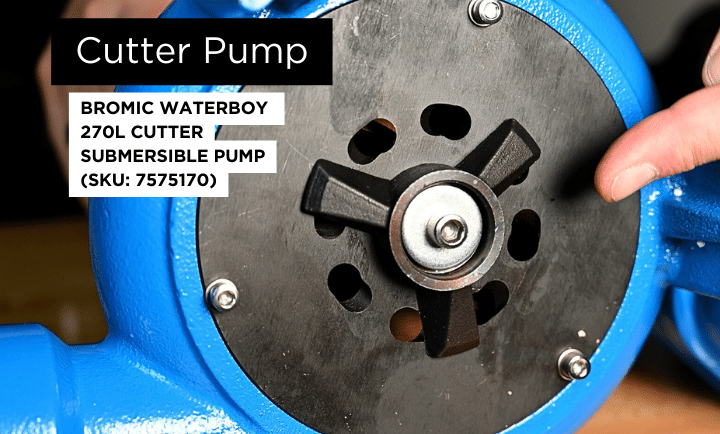
Grinder Pumps can also handle raw sewage and is capable of macerating materials finely into a slurry. As grinder pumps can grind soft solids into much finer pieces when compared to a cutter pump, grinder pumps can be used with smaller-diameter pipes (therefore saving on construction costs). It can handle a wider range of materials including thin rubber products (like ropes and cords) and even some textiles in suspension.
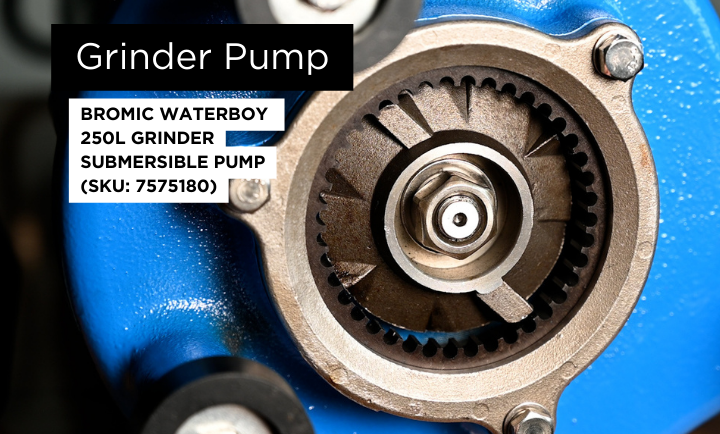
| Feature | Cutter Pump | Grinder Pump |
| Materials |
|
|
| Energy efficiency | Typically requires less power than a grinder pump to operate | Requires more power |
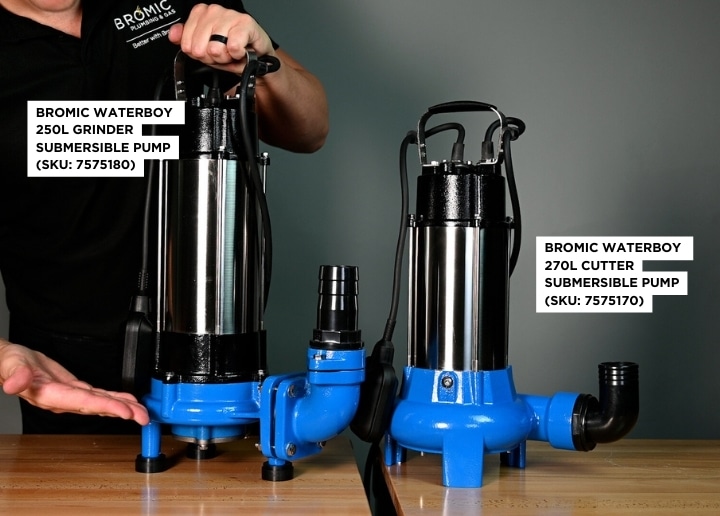
The Waterboy Pump range includes a 250L Grinder and a 270L Cutter pump, with cutting mechanisms designed for shredding of various materials in wastewater applications. Each features a built-in thermos cutoff device with auto-reset function along with a durable 10m , designed to withstand weather, UV, and oil.
